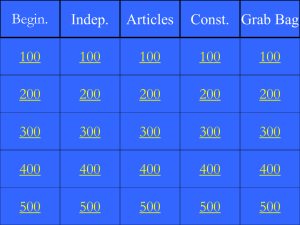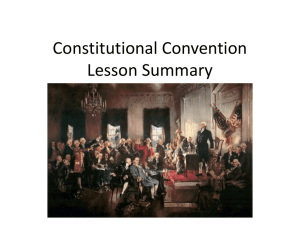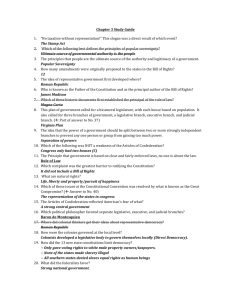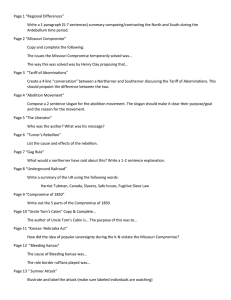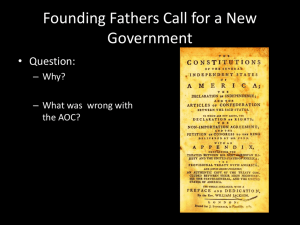review sheet answers - Wantagh Union Free School District
advertisement
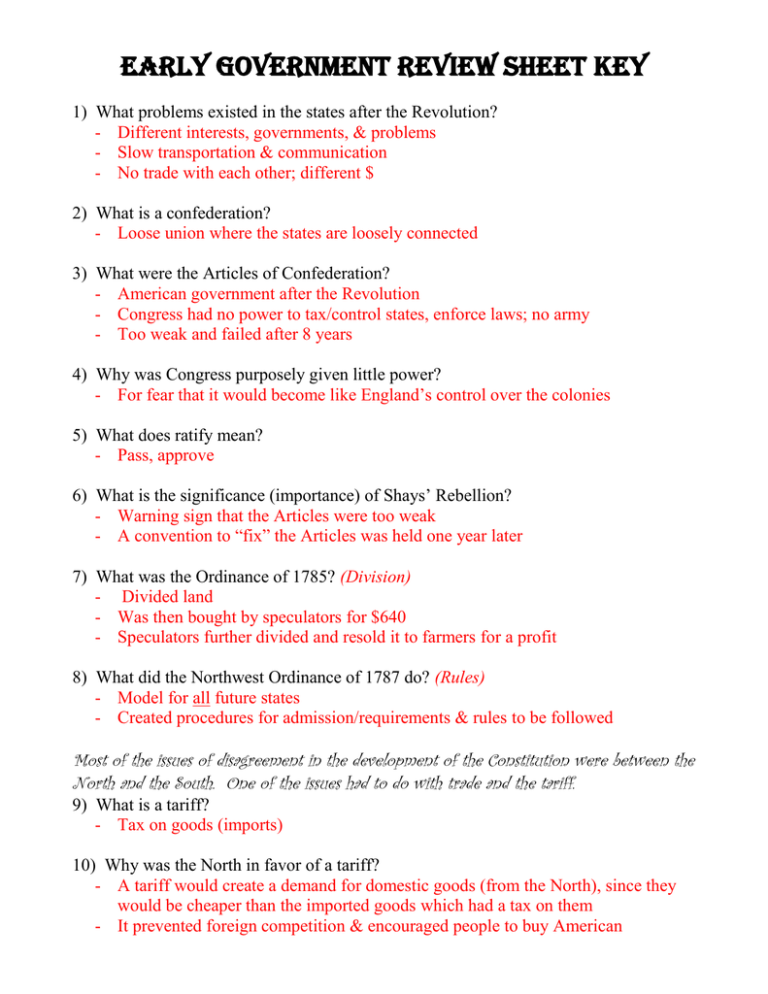
Early Government Review Sheet Key 1) What problems existed in the states after the Revolution? - Different interests, governments, & problems - Slow transportation & communication - No trade with each other; different $ 2) What is a confederation? - Loose union where the states are loosely connected 3) What were the Articles of Confederation? - American government after the Revolution - Congress had no power to tax/control states, enforce laws; no army - Too weak and failed after 8 years 4) Why was Congress purposely given little power? - For fear that it would become like England’s control over the colonies 5) What does ratify mean? - Pass, approve 6) What is the significance (importance) of Shays’ Rebellion? - Warning sign that the Articles were too weak - A convention to “fix” the Articles was held one year later 7) What was the Ordinance of 1785? (Division) - Divided land - Was then bought by speculators for $640 - Speculators further divided and resold it to farmers for a profit 8) What did the Northwest Ordinance of 1787 do? (Rules) - Model for all future states - Created procedures for admission/requirements & rules to be followed Most of the issues of disagreement in the development of the Constitution were between the North and the South. One of the issues had to do with trade and the tariff. 9) What is a tariff? - Tax on goods (imports) 10) Why was the North in favor of a tariff? - A tariff would create a demand for domestic goods (from the North), since they would be cheaper than the imported goods which had a tax on them - It prevented foreign competition & encouraged people to buy American 11) Why was the South against a tariff? - The South exported a lot of crops and didn’t want to pay a tax to do so 12) What is a compromise? - An agreement where each side gives in a little 13) What was the compromise over the tariff? - Only imports would be taxed (this made the North ) - NOT exports (this made the South ) - Congress would control trade between the states Another area of disagreement was over the counting of slaves for representation. 14)What was the position of the North? - Slaves should not be counted as part of a state’s population total 15)What was the position of the South? - Slaves should be counted as part of a state’s population total 16)What was the compromise? - 3/5th Compromise - Every 5 slaves would count as 3 people for the purpose of representation - For example: 100,000 people would be counted as 60,000 Another area of disagreement was over the importing of slaves. 17)What was the position of the North? - They were abolitionists and anti-slavery - Slavery is inhumane and cruel 18)What was the position of the South? - They were pro-slavery - Their economy depended on slave labor 19)What was the compromise? - Slavery would be discussed again in 20 years - Right now they were preoccupied w/making the new government A major area of concern was between the large states and the small states over the format of the government. 20) What is a federal system? - When the power is shared between the individual states and national government - The federal (national) government has the final say 21) What is a bicameral legislature? - Two houses (parts) legislature 22) Explain fully the Virginia Plan. - Representation would be based on population - The more people you had, the more representatives you would have - Larger states (population wise) like Virginia, favored this plan 23) Explain fully the New Jersey Plan. - Representation would be based on equality - Each state would have 2 representatives…no matter how populated - Smaller states (population wise) like New Jersey, favored this plan 24) The Great Compromise has pieces of both plans. How is the representation in Congress divided today? - Today’s Congress is bicameral: a) House of Representatives- states receive representatives based on their population (Virginia plan) b) Senate- there are 2 senators per state; equal (New Jersey plan) 25) How did this satisfy both plans: a) The small states were pleased because…they were guaranteed equality in the Senate b) The large states were pleased because…they were guaranteed that their population would be counted for the House of Representative 26) What is a Federalist? - Supporter of the Constitution and a strong federal government 27) What is an Anti-federalist? - Against the Constitution and a strong federal government - Prefers the States to have more power 28) What is a bill of rights? - A basic guarantee of personal rights 29) How did the Federalists convince the Anti-federalists to sign the Constitution? - Using the Federalist Papers - By adding the Bill of Rights

